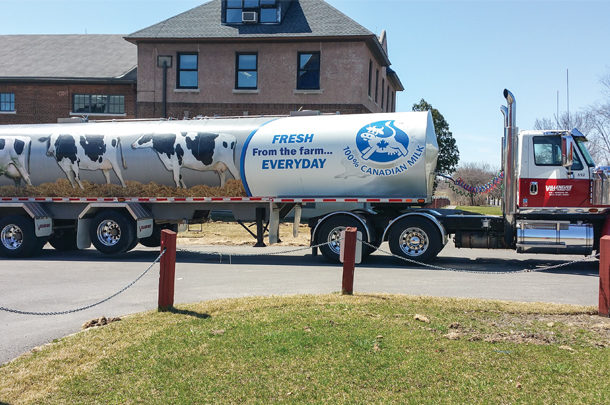Dairy Farmers of Canada (DFC), in conjunction with all 10 provincial dairy organizations, has moved to get out in front of the debate on the major issues for the dairy sector with its proAction initiative.
The program aims to strike a balance with an industry-designed program all dairy farmers will have to comply with which is proactive and mandatory at the same time.
Generally described as a “sustainability initiative” by DFC, the proAction program was officially launched on April 19, 2016, in Ottawa at the Canadian Museum of Agriculture and Food.
The program sets out national standards for milk quality, food safety, animal care, livestock traceability, biosecurity and the environment – all big-ticket items with regard to the social licence to produce milk.
Some of these elements have been underway for several years, such as Canadian Quality Milk, which now has 99 percent of Canadian dairy farmers certified through a validation process designed to prevent, monitor and reduce food safety risks such as contaminated milk.
Other components of the program are just picking up steam, such as higher animal welfare standards. The program brings all six elements under one roof with a timeline for implementation through to 2023 and an emphasis on comprehensive compliance – one set of national standards for all provinces and all dairy farmers.
A tough challenge for any industry, but DFC President Wally Smith thinks it is achievable because the program has been “designed by farmers, for farmers,” so there’s something in the deal for producers, as well as for consumers and the industry in general.
“This will make it easy to answer questions about the dairy industry,” Smith says, an important aspect given the $18.9 billion contribution to Canadian GDP that originates at the farm gate of the country’s 12,000 dairy farms.
A dairy farmer himself from Vancouver Island, British Columbia, where he owns and operates a 75-cow dairy farm, Smith adds that dairy producers will more than offset any costs through increases to productivity and improved milk quality.
All six elements of the program have or will go through a develop-test-implement-validation process to make sure the standards are both practical at the farm level and produce the intended outcome over time.
“Animal care comes naturally to many farmers, but we still have to work with the experts,” says David Wiens, DFC vice-president and chair of the proAction Advisory Committee. “It’s true that a happy, healthy cow produces more and better-quality milk,” he adds.
Wiens also notes the individual elements of the program are not unique (i.e., there are traceability programs in different provinces), but the comprehensive nature of the program is what makes the initiative stand out.
In February 2014, at the DFC Policy Conference, the financial investment estimate for proAction was in the order of $83 million in cash and 3.6 million hours of in-kind contribution over 10 years.
This figure included the financial assistance provided by governments in Growing Forward 1 and 2 for market assurance programs. Dairy farms will spend $64.7 million on related tests, assessments and validations over the 10 years, or about $688 per farm per year on average.
In addition to the establishment of national standards, the program is also underpinned by two fundamental pillars to maintain the momentum of the initiative: measurable metrics and continuous improvement.
Measurable metrics means paperwork for dairy farmers but will also provide the basis for benchmarking between farms and between provinces to monitor progress.
The data will also contribute to building an evidence base the industry can use to rebut the many claims that are regularly made against the dairy sector with regard to everything from animal welfare to use of antibiotics.
The program will include independent audits to ensure the credibility of the data. DFC will be working in collaboration with Holstein Canada classifiers who have been selected to assess and benchmark animal-based measures on all dairy farms in Canada between 2016 and 2018.
Further details on the program and standards being implemented can be found online Dairy Farmers of Canada: proAction Initiative. The second pillar will be continuous improvement, which will not only help dairy farmers to produce a better product but also avoid the need for implementing another substantial proAction-type initiative 10 years from now.
“Continuous improvement is necessary for sustainability,” says Pierre Lampron, a member of the DFC board of directors responsible for the animal welfare component of the program. “We need to be able to transfer our farms (to the next generation) and for consumers to have an excellent opinion of our efforts.”
Lampron, who produces organic milk from 140 cows in Saint-Boniface, Quebec, notes having the supply management system gives an advantage to the proAction program given that all milk has to flow through the same channels.
“These things, such as animal welfare, are already in place. We’re just certifying what we already do,” he concludes. PD
PHOTO: As part of the proAction program, Dairy Farmers of Canada is using milk trucks to help demonstrate the Canadian Quality Milk component. Photo by Hugh Maynard.

-
Hugh Maynard
- Freelance Writer
- Manager of Qu'anglo Communication
- Ormstown, Quebec
So, what will proAction mean for dairy farmers in concrete terms?
few examples ...
Food safety
Records that indicate whether:
- The milk is being kept cool enough.
- The equipment is properly sanitized after milking.
An independent audit every second year, farmer self-declaration on alternate years; randomly selected farms will receive additional validation.
Animal care
Development of a Code of Practice that will have on-farm assessment for compliance:
- No tail docking
- Pain control in health procedures
- Calf feeding and colostrum management
- Shipping practices and euthanasia
- Training for handling cattle
- Record-keeping
Biosecurity
Measures to manage the spread of disease:
- Separation of new and young animals from main herd
- Closed herd or buying cattle from trusted sources
- Keeping equipment and housing clean
- Visitors to wear farm-supplied boots or shoe covers









